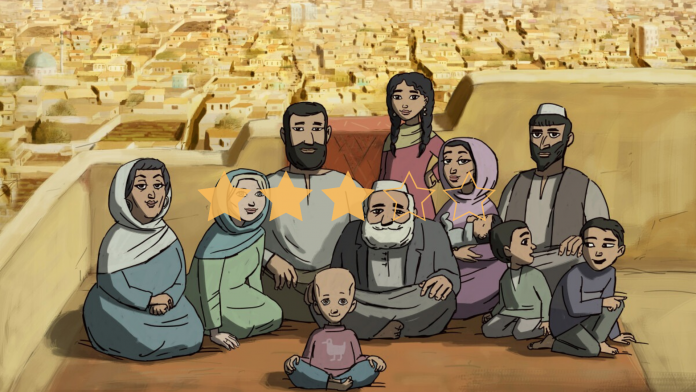In her first feature-length animation, Michaela Pavlátová’s perspective on Afghani culture plays dangerously close to the line of stereotyping, oppression and social demonisation.
★★★✰✰
As a general rule of art and storytelling, any marginalised voice depicted in a state of oppression needs to be heard. Any culture that has a social view unfairly warped by a Western lens deserves a platform all their own. The melding of these two ideas should sing success, yet Michaela Pavlátová’s My Sunny Maad somehow misses the mark. Told through sequences of intricate animation, the peaks and pits of intercultural marriage are pulled apart with a one-sided bias.
Herra (voiced by Eliska Balzerová), a young Czech woman, falls in love with Afghani Nazir (Hynek Cermák) while studying in Prague. Moving to a post-Taliban Afghanistan with no sense of expectation, Herra must navigate her life as a bride in a foreign landscape. With a cautiously liberal Grandfather, an unconventional adopted child and half-sisters desperate to escape domestic violence, the family’s boundaries of social norms are pushed to the point of life-threatening danger.
Pavlátová is taking on a huge wealth of cultural questions in My Sunny Maad, and a lot of her answers are successful. Notions of body image, male entitlement and obedience are challenged head on, weaved into the fabric of every character. The narrative journeys of half-sister Freshta and niece Nafisa are the jewels in the film’s heart-breaking crown, grappling with the effects of enforced patriarchy that endanger their safety. In their own way, each family member embodies a feeling of dissociation, making the company of social outcasts a satisfying cinematic blanket. A game of both simplicity and complexity, there’s no doubting Pavlátová’s triumph in dissecting a woman’s place and the looming impacts of Westernisation.
The main issue with My Sunny Maad is the decision to prioritise the white experience. Understandably, this is initially rooted in personal experience, adapted from a novel written by Petra Procházková, once a Czech bride herself. However, it’s to the detriment of the screenplay that none of the creators have any obvious links to Afghanistan. ‘White’ is viewed as safe or a solution, while the East is traditionally oppressive and backward. The injection of an American presence (albeit posing an extremely interesting stance on women’s gynaecological health) feels like blatant saviourism, the obvious answer to women of colour looking for a better alternative. There are certain parts of this thinking that may well have truth—it’s no secret that many corners of the world equate womanhood to fertility, or children. But it conveys ignorance—and a staggering lack of perspective—that a white woman’s experience of violent patriarchy is viewed as more important to fix than the millions of Afghani women in similar circumstances.
To the team’s merit, there are efforts to dissuade this thinking. Herra’s husband Nazir delicately straddles the line of gentile compassion and respect of his Afghani background, helping to cover up his wife’s lack of virginal blood in their married bedsheets. There’s a sense of empowerment behind Herra’s decision to stay in her husband’s homeland, almost retaliating against the sense of Western ‘betterism’ whilst remaining obedient. Yet with the same hand, the respecting of a woman’s choice is swatted away—burqas are verbally declared to make a woman invisible, and characters of colour lack any form of realistic agency.
As two tales that intertwine facets of Afghani culture in animation, it’s difficult not to compare My Sunny Maad to the London Film Festival success story of Flee. The latter acts as a pillar example of how to approach an Afghani story from a white lens with integrity, honest compassion and a lack of self. The quality of cinematography, craft and narrative structure result as equally beautiful in both, yet one champions the value of humanity distinctly better than the other.
The Verdict
My Sunny Maad doesn’t teach anything new to a wider global audience. Perhaps this is due to more successful glimpses into Afghani culture like Flee and The Kite Runner, equipping the kind of viewer likely to see the film with a broadened definition of Afghanistan in context. Yet despite upholding a number of tired rhetorics, the cultural significance and voice of My Sunny Maad does not lose its importance.
Words by Jasmine Valentine
Support The Indiependent
We’re trying to raise £200 a month to help cover our operational costs. This includes our ‘Writer of the Month’ awards, where we recognise the amazing work produced by our contributor team. If you’ve enjoyed reading our site, we’d really appreciate it if you could donate to The Indiependent. Whether you can give £1 or £10, you’d be making a huge difference to our small team.
